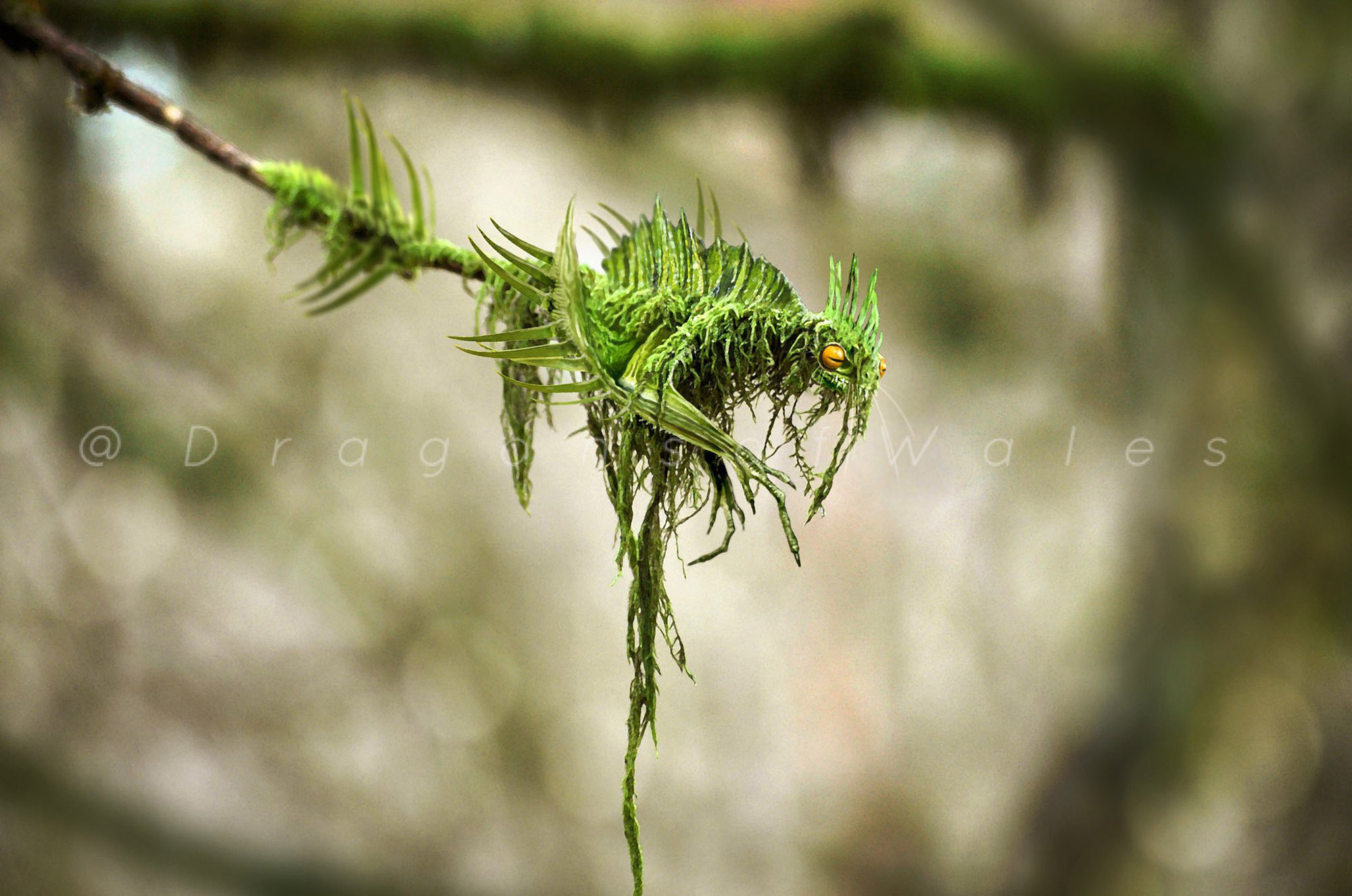Leafwyrm
The leafwyrm is a tiny pseudodraconic monster, related to the Dragon. It is most notable for its symbiotic relationship with trees, in which it merges with a tree branch for life and acts as that tree's sentinel, steward, and defense mechanism.
Basic Information
Anatomy
Leafwyrm hatchlings are bright green and have a traditional dragon-like anatomy, with four legs and a pair of wings. They emerge from their pupae around 1 inch long, and can grow to 5-12 inches in length during their mobile phase. Once attached to a host tree, they take on physical characteristics to match the tree or its other symbiotes: changing color, morphing their wings into imitation leaves, and/or growing lichen-like tendrils of feathers. Their bright golden eyes remain visible throughout their lifetime; these are often the only immediately visible signs that they are here.
Genetics and Reproduction
Each winter, a male leafwyrm deposits a pollen-like substance into the tree that sustains it. When the tree releases pollen, it also releases the pollen of the leafwyrm, which spreads to female leafwyrms via the wind or via pollinators like bats, insects, and Sprites. A pollinated female leafwyrm grows an apricot-like fruit from her throat in the spring, which contains a smooth pit like a pupa. This fruit contains a potent magic-resistant neurotoxin that cannot be purified and requires high-level magic to dispel. It kills a humanoid within approximately 24 hours.
Growth Rate & Stages
Leafwyrm hatchlings begin life by emerging from the tough, pupa-like shells within its fruit, which bury themselves in the ground as the fruit rots. The leafwyrm emerges after 2-3 months of hibernation. It is able to fly shortly after birth, and uses the next several months of its life to find a suitable tree to merge with. Leafwyrms must make this decision quickly, as an unattached leafwyrm is highly susceptible to the cold and will die if not attached to a tree by the onset of winter.
Once a leafwyrm has settled on a branch, it slowly merges with the tree, until it is unable to move. It will remain there for the rest of its life.
A leafwyrm dies when its tree dies, or when it is separated from the tree.
Ecology and Habitats
Leafwyrms always live in forested areas, typically far away from civilization. The majority of them prefer deciduous or mixed forests. A few subspecies have adapted to coniferous forests and subtropical jungles.
Dietary Needs and Habits
Leafwyrms are both insectivores and photosynthesizers. They release pheromones like a pitcher plant does, enticing nearby insects. These pheromones are particularly effective on any species that preys upon its host tree; for instance, a leafwyrm attached to an ash tree may specifically attract emerald ash borer beetles, which will seek out the leafwyrm rather than destroying the host tree.
Biological Cycle
If attached to a deciduous tree, the leafwyrm's hide changes color with its host, and its body shrinks and flattens as the tree loses its leaves. It goes into a trance-like state, though it is still able to detect any changes to its tree and defend it from predators.
Additional Information
Social Structure
Most leafwyrms are solitary creatures. Leafwyrms are often quite territorial about their trees in the juvenile stage, fighting off others who try to settle too close to them. However, a large tree with multiple sturdy branching systems can sometimes support up to a dozen leafwyrms
Uses, Products & Exploitation
The highly toxic fruit that the leafwyrm produces in the spring is difficult to obtain because of the leafwyrms' remote habitats and vicious defense of their tree. However, if picked when ripe, the flesh strongly resembles an apricot, albeit with a slightly more intense taste. This, and the deadliness of its slow-acting poison, make it an ideal assassination method. Possession and transport of leafwyrm fruit is universally a felony.
Geographic Origin and Distribution
Leafwyrms are primarily concentrated in heavily wooded areas of the Belcantas mainland, such as the Eldar Wood of Scalados and the Gaeno Woods on the Haldara Peninsula. A few have migrated into the Feywild.
Average Intelligence
Leafwyrms have limited intelligence, but still possess a sliver of the spark of a draconic brain. Most can understand Draconic, and some who live in the Feywild or near its portals can also understand Sylvan. They communicate most easily with Humanoid species through the Druid ritual tongue, often to give warnings of nearby predators or report on the health of their host tree.
Perception and Sensory Capabilities
Leafwyrms connect with the chemical network of the tree they merge with, and can communicate through pheromones and soil alongside the tree. They are born with the extraordinary vision of a dragon, but this sense fades to a degree over time, replaced with similarly incredible olfactory perception.
Leafwyrms are able to spit a sticky orange toxin, propelling it up to 20 feet in front of them in the manner of a draconic breath weapon. For close-range threats or prey, they release a butt of insecticidal gas powerful enough to create a slowing effect even on much larger creatures.
Symbiotic and Parasitic organisms
Leafwyrms can form a symbiotic relationship with any tree, though they tend to prefer long-lived broadleaf deciduous species like oaks.
Lifespan
Varies, but can exceed 300 years
Related Ethnicities



Comments